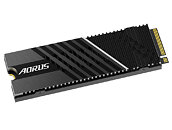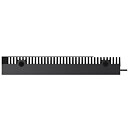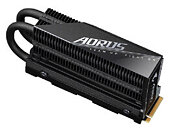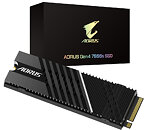Monday, January 18th 2021

GIGABYTE Launches the AORUS Gen4 7000s M.2 NVMe SSD
Gigabyte Technology, one of the top global manufacturers of motherboards, graphics cards, and hardware solutions, announces today the latest AORUS Gen4 7000s SSD with up to 7 GB/s read speed. Enhanced by the new generation PCIe 4.0 controller with advanced 3D-TLC NAND Flash, it boosts up to 55% more performance than previous generation PCIe 4.0 NVMe SSD. AORUS Gen4 7000s SSDs come in two capacity variants, 2 TB and 1 TB with M.2 2280 interface to make installation easy. They equip big aluminium thermal interface in different sizes and double side thermal pad with Nanocarbon coating for improved heat dissipation. Meanwhile, the SSD Tool Box application provides the instant overview and adjustment of SSD status.
"The storage devices are taking advantage of the PCIe 4.0 transfer speed that raised from 5 GB/s to almost 8 GB/s, which is great news for users who expect to optimize storage performance and reduce the bottle neck of system operation." said Jackson Hsu, Director of the GIGABYTE Channel Solutions Product Development Division. "AORUS Gen4 7000s SSDs further advance the standards set by our previous SSD products to provide users with breakthrough performance. After the OS installed, uses can enjoy unprecedented 7 GB/s read speed with 1 TB or 2 TB storage capability. The thermal solution and the double-sided thermal pad are designed to slow down the throttling that might occur at high-speed operation of SSD, thus boost the system performance."AORUS Gen4 7000s SSDs equip the latest Phison E18 selected 8-channel controller, which provides users with ultimate random access rate, as well as the high speed 3D-TLC NAND Flash and SLC cache design that brings the PCIe 4.0 into full play. Under the real test, AORUS Gen4 7000s SSD features read speed up to 7 GB/s and write speed up to 6.85 GB/s, which is 55% faster than PCIe 4.0 NVMe SSD, two times faster than PCIe 3.0 SSD, and up to 13 times faster than SATA SSD. Enhanced by Phison's E18 controller, AORUS Gen4 7000s SSD not only improves AI multitasking operation, but power up content creators, gamers, and users eager for extreme performance.
The high-speed SSD generates heat on full speed operation, and normally thermal throttling is implemented as a safety feature to prevent data loss, or wear-out the memory chips and controllers. The throttling state engages to maintain the stability and durability, however it slows down the performance and it reduces the transfer rate. In order to keep AORUS Gen4 7000s SSD cool while it is running at high speed, GIGABYTE employs the special-designed double-sided aluminium heatsink with Nanocarbon coating. By utilizing the clearance area smartly between slots on motherboards, the size of the thermal fins can be maximized to enlarge the surface area of dissipation. This design can support different M.2 slots perfectly on various motherboards to avoid possible interference by VGA cards installed above the M.2 SSD. AORUS Gen4 7000s SSD also equip high conductivity thermal pad to improve heat dissipation 30% better than metal thermal pad.
For those progressive M.2 users who prefer more extreme thermal solution without installing SSDs between PCIe expansion slots, AORUS Gen4 7000s SSD comes in another version of heatsink with integrated heatpipes. With the same double-sided heat spreader with Nanocabon coating and high conductivity pad design, but optimized on the height and dissipation area, AORUS Gen4 7000s SSD promises the consistent cooling and high performance for those water cooling users to avoid throttling from the overheating caused by no air flow assistance of the CPU fan. Users can customize their thermal allocation according to personal needs by GIGABYTE's thoughtful design, which balances between the high performance and low temperature.
AORUS Gen4 7000s SSD features PCIe 4.0 NVMe M.2 interface design. To release the breakthrough performance of read speed up to 7 GB/s, AMD X570 / B550 motherboards or Intel Z490 motherboards with next-gen Intel Core processors supported are highly-recommended. With GIGABYTE R&D's professional adjustment, comprehensive verification, software enhancement, and the 5 years warranty service, GIGABYTE motherboards offers more stability with higher performance, which is definitely the best choice for users.
For more information, visit the product page.
"The storage devices are taking advantage of the PCIe 4.0 transfer speed that raised from 5 GB/s to almost 8 GB/s, which is great news for users who expect to optimize storage performance and reduce the bottle neck of system operation." said Jackson Hsu, Director of the GIGABYTE Channel Solutions Product Development Division. "AORUS Gen4 7000s SSDs further advance the standards set by our previous SSD products to provide users with breakthrough performance. After the OS installed, uses can enjoy unprecedented 7 GB/s read speed with 1 TB or 2 TB storage capability. The thermal solution and the double-sided thermal pad are designed to slow down the throttling that might occur at high-speed operation of SSD, thus boost the system performance."AORUS Gen4 7000s SSDs equip the latest Phison E18 selected 8-channel controller, which provides users with ultimate random access rate, as well as the high speed 3D-TLC NAND Flash and SLC cache design that brings the PCIe 4.0 into full play. Under the real test, AORUS Gen4 7000s SSD features read speed up to 7 GB/s and write speed up to 6.85 GB/s, which is 55% faster than PCIe 4.0 NVMe SSD, two times faster than PCIe 3.0 SSD, and up to 13 times faster than SATA SSD. Enhanced by Phison's E18 controller, AORUS Gen4 7000s SSD not only improves AI multitasking operation, but power up content creators, gamers, and users eager for extreme performance.
The high-speed SSD generates heat on full speed operation, and normally thermal throttling is implemented as a safety feature to prevent data loss, or wear-out the memory chips and controllers. The throttling state engages to maintain the stability and durability, however it slows down the performance and it reduces the transfer rate. In order to keep AORUS Gen4 7000s SSD cool while it is running at high speed, GIGABYTE employs the special-designed double-sided aluminium heatsink with Nanocarbon coating. By utilizing the clearance area smartly between slots on motherboards, the size of the thermal fins can be maximized to enlarge the surface area of dissipation. This design can support different M.2 slots perfectly on various motherboards to avoid possible interference by VGA cards installed above the M.2 SSD. AORUS Gen4 7000s SSD also equip high conductivity thermal pad to improve heat dissipation 30% better than metal thermal pad.
For those progressive M.2 users who prefer more extreme thermal solution without installing SSDs between PCIe expansion slots, AORUS Gen4 7000s SSD comes in another version of heatsink with integrated heatpipes. With the same double-sided heat spreader with Nanocabon coating and high conductivity pad design, but optimized on the height and dissipation area, AORUS Gen4 7000s SSD promises the consistent cooling and high performance for those water cooling users to avoid throttling from the overheating caused by no air flow assistance of the CPU fan. Users can customize their thermal allocation according to personal needs by GIGABYTE's thoughtful design, which balances between the high performance and low temperature.
AORUS Gen4 7000s SSD features PCIe 4.0 NVMe M.2 interface design. To release the breakthrough performance of read speed up to 7 GB/s, AMD X570 / B550 motherboards or Intel Z490 motherboards with next-gen Intel Core processors supported are highly-recommended. With GIGABYTE R&D's professional adjustment, comprehensive verification, software enhancement, and the 5 years warranty service, GIGABYTE motherboards offers more stability with higher performance, which is definitely the best choice for users.
For more information, visit the product page.





37 Comments on GIGABYTE Launches the AORUS Gen4 7000s M.2 NVMe SSD
A yet completely useless, gimmick. SSD's need to run hot; at least within the 60 to 70 degrees mark for best performance.
Even with a regular heatsink the SSD will be fine.
I like heatsinks but dang that's whack :-)
TBW ( tera bytes written ) number...
Seriously, that thing is significantly bigger than most 15-25W laptop heatsinks. It could probably cool a 35W CPU decently with direct-die mounting.
My Adata SX8200 Pro 2TB in a B450 board. I've always read the 4KiB Q1T1 is what a user "feels"...seems all these newer NVME drives are niche products for people doing heavy lifting. Video editing and AI and such. Especially when you throw price in the mix.
*edit*
And I never even installed the heatsink on my drive.
www.gigabyte.com/Motherboard/B550-VISION-D-P-rev-10#kf